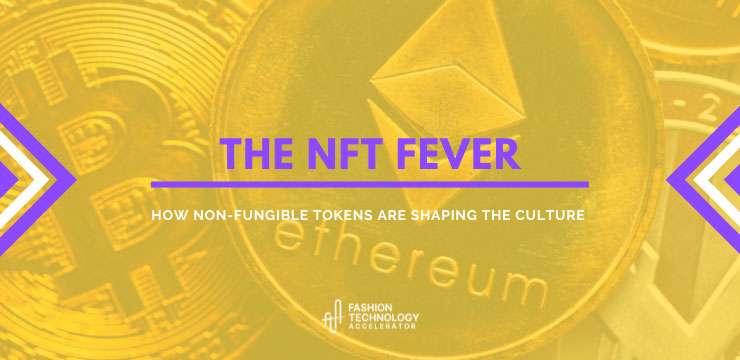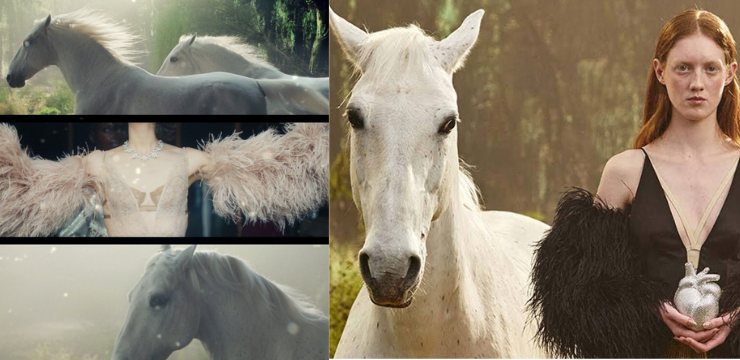
The fashion industry has historically been in the front rows of innovation, from the invention of the mechanical loom of the first Industrial Revolution in the 18th century to the newest AR technologies employed in virtual fitting rooms. Yet, there is still some uncertainty about which could be the most successful use of an increasingly renowned technology, the non-fungible tokens (NFTs).

NFTs are digital coins, non-replicable and non-exchangeable, whose existence is registered in a digital ledger through the use of blockchain technology. Despite the fact that startups like the Sydney-based Neuno are striving to make payments by credit card viable for this type of purchase, NFTs can nowadays only be exchanged via cryptocurrencies like Bitcoins or Ethereum.
However, NFTs are not bargaining chips per se: they are a digital certificate, unique and personal, that guarantees the authenticity of a good, which can be either entirely digital or with a physical counterpart. Having bought an NFT allows one to have the exclusive ownership of an inimitable and iconic object, not only in the immaterial world of the
The first NFT ever was “minted” in 2014, based on the unprecedented intuition of Kevin McCoy. In the beginning, nobody was understanding what the visionary American artist was saying when he had the idea of combining art and blockchain technology together. The NFT he created was the art piece “Quantum”, which was auctioned at Sotheby, a generative artwork entirely made with code that automatically permeates into new forms that are not determined at the outset.
Staying faithful to their nature, NFTs have thus boomed in the art world at first, where impressive prices were paid for digital artworks such as the American artist Beeple’s “

And here we go with the first truly disruptive aspect of NFTs: this trading option allows creators to receive a percentage of each subsequent sale of the NFT they realized, getting a percentage on each transaction. So, for instance, in case MetaKovan decided to sell single parts of Beeple’s work, a percentage of the countervalue would go to the artist. Indeed, if the artist, brand
This would solve some of the problems that have characterized the resale market for decades, having great implications for the world of creative people, ranging from musicians to photographers and, of course, artists, as it represents an impenetrable way of protecting intellectual property which relies on ciphered codes and encryptions.
Talking about the “property” side of it all, it is undeniable that another great perk of NFTs is that they endow buyers with the sense of owning a digital asset, of being the unique possessor of a good, and this concept has the potential to significantly close the gap between the virtual and the physical world. This could also possibly entice more businesses heavily dependent on “material” components (i.e. textures, fibres
Taking off from the art world, NFTs have found thriving applications in other dimensions. In music, for instance, the band Kings of Leon sold their latest album via NFTs and made more than $2 million from the sales, Grimes sold 10 digital works on NFT marketplace Nifty Gateway for nearly $6 million in March 2021. A unique version of the Nyan Cat, a flying cartoon that first went viral on YouTube about ten years ago, sold for $580,000 in February 2021.
In the sports dimension, the NBA has been the most attractive target as of now for NFTs. Indeed, basketball fans can check out NBA Top Shot, a marketplace stemming from the partnership between NBA and blockchain company Dapper Labs where a LeBron James video of a dunk recently sold for $208,000.
Getting closer to the fashion world, two interesting examples feature the model and digital activist Emily Ratajkowski. Building on the NFTs’ momentum, she advocated for regaining ownership of her own image: in May 2021, the provocative “Buying Myself Back: a Model for Redistribution” was auctioned by Christie’s. This NFT was created as a protest of the model against the undue appropriation of other people’s image; and again, here we go with the authenticity- and originality-shaped essence of NFTs, pivotal in their present and future success.

Another emblematic example is the photographic legacy of Karl Lagerfeld, the iconic creative director of Chanel and Fendi, which has been registered on the Lukso blockchain.
For the sake of clarity, three important aspects need to be set out: the first one is that whoever is going to buy the NFT will be the legitimate owner of the digital asset; secondly, the digital asset is unique and inimitable; and thirdly, if to be resold, the buyer will only get a share of the resell price, since a fixed quota will be devolved to the original creator.

Currently, the NFT trend is representing physical assets in the digital world. For some, the exciting future of NFT is all digital. In the fashion realm, designers will be able to give free rein to creativity and produce digitally something that is not feasible materially. In the words of Amber Jae Slooten, co-founder of The Fabricant, “brands [should not] simply copy their physical items,” she says. “I would encourage them to go beyond their physical reality. For instance, we designed one shoe that was a flaming shoe. You can create all kinds of digital couture looks that could never exist in real life.”
But how is the fashion industry currently reacting to this new technological as well as conceptual trend? The first blatant example of the great potential NFTs have in the world of fashion is testified by the recent collaboration between the 18-year-old designer Fewocious and the virtual sneaker brand RTFKT Studios, who sold the whole sneaker drop in seven minutes generating $3.1 million gain.
There are many other interesting uses

There are other possible uses of NFTs suggested by celebrity art dealer, manager and founder of ArtGrails NFTs’ marketplace Avery Andon. He told Glossy Fashion Magazine that Prada could for instance embed an NFT in every physical product it sells as well as the NFT representing a ticket to a Prada fashion show for a selected drop of shoes.
Moreover, NFTs could also authenticate high-value goods and prevent counterfeits from going off, as they provide a great way to block things like massive counterfeiting attacks. Again, Avery said that by adding an NFT to every watch you sell it would be possible to track them all perfectly and be in full control of both the way they are sold and who the buyer is.
NFTs may also represent a viable complementary feature for emerging or already well-established trends. For instance, NFTs could be a great ally of luxury brands in second-hand markets of pre-loved items: issuing an NFT every time a luxury item is sold would be a great way of still providing the qualities of authenticity and exclusivity so essential to high-end brands.
Concerning emerging trends, NFTs could be a valid resource in the increasingly popular combo of fashion brands and gaming, as well as AR fashion. Indeed, luxury brands could expand their revenue stream by creating unique and non-replicable skins for video games, or could embed in each physical product sold in their brick-and-mortar stores an NFT, giving access to the digital dimension of that very product. This would on the one hand increase affluence to flagship stores, and on the other could make more headway for fashion brands in the virtual space avoiding the risk of dilution – again, due to the exclusivity and authenticity connected to each NFT issued.
NFTs would also go perfectly with the “metaverse”, a virtual world where people interact with each other through avatars, a trend that has seen a great surge throughout 2021, as noted by Martha Bennett, Forrester’s VP.
All in all, The Business of Fashion noted that the greatest untapped potential is still anchored to the physical world when it comes to fashion. A real-life example of this could be Clothia, an online retailer in the accessible luxury space which is currently auctioning NFT dresses. The winning bidders will receive the corresponding real-life dresses, and both the NFTs and the physical garments are one of a kind according to Clothia CEO Elena Silenok.
Over centuries, people have given physical objects a value that can go far beyond their intrinsic worth. For instance, the price of a famous painter’s artwork immeasurably outweighs the costs of the oil and canvas used, and this is even more evident as the artist’s reputation and popularity increase. Notably, the same applies to the fashion industry with garments and accessories.
Fashion is the way human beings portray themselves to the outside world, and fashion objects are the means through which they primarily express their own identity. Collecting items that enable you to build your own identity, whether you are going to wear them or not, is a primary human tendency. Given the prominence the digital world has acquired in our daily lives, from social media to metaverse and augmented reality, this natural aptitude has progressively shifted the focus also on digital stockpiling.
But many complain about NFTs being too expensive, given that they lack physical substance. “People are still not used to digital goods [coming] with a certain price,” says Gala Marija Vrbanic, co-founder of Tribute. “This is mostly because they can’t touch or experience those pieces in the real world, so they don’t feel like they own them. NFTs have managed to succeed in giving the people this ownership feeling.”
Not surprisingly, the nature of NFT perfectly matches the world of collectors. The latest NFT auctions witnessed a huge amount of money bid, which for some may seem absurd. On the contrary, those who have been in the market for years, like collectors, seek exclusivity and uniqueness. NFTs offer exactly these qualities, representing the quintessence of luxury being certifiable, authentic, unique and non-replicable.
Some of the biggest fashion collectors are sneaker-enthusiasts: NFTs may easily enter this market since the concept behind them is not at all far from how collecting these items is currently perceived. Most “sneakerheads” purchase the shoes exclusively to display or hold on to them waiting for future price appreciation. It is already considered a long-term investment.

For some, the evolution of fashion into the digital world is an opportunity to explore new and different paths, diverting from the extremely polluting environment that characterizes the industry. In fact, brands tend to overproduce, especially in the fast fashion segment, in order to meet the quickly changing demand and tastes of customers. As the customer base has become more aware of this problem over the years, also brands established plans to become more sustainable and reduce their carbon footprint.
Although NFTs could provide several benefits to brands, they are not cost-free. In particular, NFTs are traded using cryptocurrencies like Ethereum and Bitcoin, which are known to be environmentally costly. To work, cryptocurrencies are “mined” by computers doing power-intensive calculations to verify each part of the blockchain. Researchers showed that the “mining” process of Bitcoin alone consumes per year as much energy as Argentina. NFTs themselves are created through a process called “proof-of-work” (PoW) based on Ethereum blockchain, which as we have seen necessitates a large amount of processing machines.
Many well-established fashion brands have sustainability as one of their core values. Those very brands, however, are the ones hopping on the new NFT trend, trying to appeal to a new, young, tech-savvy customer base. The continuous need to innovate and to be forward-looking may, in the case of NFT, not be fully compatible with the brands sustainability objectives. Furthermore, they might incur the risk of greenwashing, and this could damage the reputation brands have built over the years.
While some NFT artists committed to carbon offsets, critics say that the problem is not finding a sustainable way but the NFT itself. In order to overcome the issue, a new process called “proof-of-stake” (PoS) was developed, and it requires significantly less energy to verify the blockchain. Immediate feedback showed that NFTs could not be verified the same way, slowing down the shifting process towards this alternative.

Indeed, many fashion brands are still waiting before fully buying into NFTs, and this is not only connected to the complexities related to the sustainable side of the deal.
Another tough aspect is represented by the volatility of cryptocurrencies, which, without a doubt, is strongly linked to NFTs’ potential instability. Indeed, if in 2020 the overall value of the NFT market has soared by 299 percent according to Atelier BNP Paribas and Nonfungible.com. However, 2021 has seen a plunge in the overall value of sales: from May 3, 2021, to last June 4, sales decreased by over 90 percent.
The fact that NFTs’ market transactions tend to fluctuate a lot over time, along with the very volatile currencies exchanges rely on, makes it crystal clear that NFTs are still far from being brands’ first option in terms of their productive investments.
Fashion brands, like any other business, need stability in their profits as well as the reasonable assurance that this is not only a temporary fad. Only time will prove it.
Come and visit our blog for further information on how the world of digital fashion is evolving. Exciting new reports and cutting-edge contents are coming up!